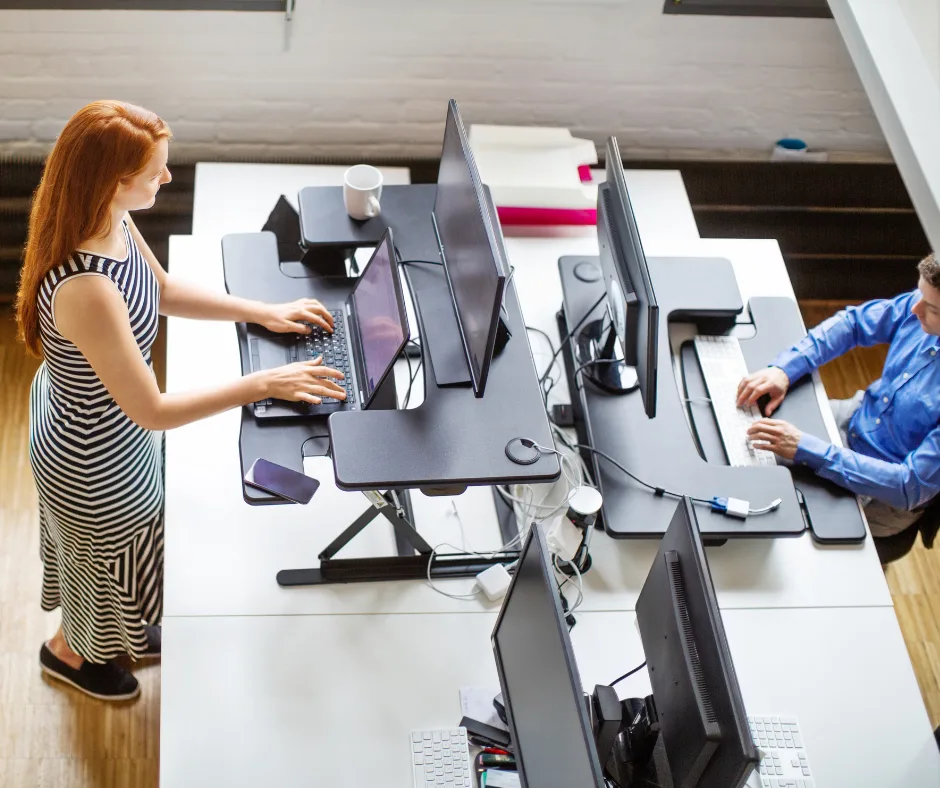I'm still standing
How to motivate your employees to actually use their sit-stand desks

Sit-stand desks are now present in many workplaces. They promise a healthier work environment and more variety during the day. But in reality?
The average employee uses the “standing” function for less than 2% of their working time.
A shame, because the benefits are clear:
- more energy and better focus
- fewer back and neck complaints
- improved blood circulation
- and even higher productivity
Yet most employees still prefer to remain seated.
Table of contents
Why alternating is important
In Belgium, the average adult sits still for 8.3 hours per day – and that’s not without consequences. Prolonged sitting increases the risk of cardiovascular diseases, type 2 diabetes, back pain, and reduced mental alertness.
Sit-stand desks are a great first step, but simply installing them is not enough. Information campaigns have limited effect. Employees often know that standing is good for them but don’t do it – out of habit, convenience, or lack of motivation.
So, how do you ensure these desks actually get used?
Working ergonomically?
We can help.
7 tips to bring dynamic working to life
1: Make alternation a policy, not a suggestion
Include dynamic working in company policies or your well-being plan. Make it clear that moving and standing are part of the workday – just like breaks and lunch.
2: Start with stand-up meetings
Try meeting while standing. It’s healthier, often more efficient, and usually shorter. Perfect for daily check-ins or quick 15-minute meetings.
3: Plan micro-breaks consciously
Encourage teams to move for 1–2 minutes every hour. Stretch, stand, fetch a glass of water – every bit helps. Add these breaks to the agenda if needed.
4: Let the computer help
1. Use simple tools or pop-ups that remind staff to stand. Research from Ghent University shows that light digital prompts can increase standing time by almost 10%.
5: Host a toolbox meeting on sitting and health
In a short session, explain what prolonged sitting does to the body. Show easy ways to alternate and let colleagues share their own experiences.
6: Make movement social
Organise team walks during lunch or let employees suggest activities. Moving together is motivating and strengthens team spirit.
7: Don’t forget about ergonomics
A sit-stand desk is a good start – but without proper posture, it’s still not ideal. Conduct an ergonomic risk analysis – legally required for new workstations and every 5 years for screen work. This helps to adjust setups and respond to evolving needs such as reintegration or physical complaints.
Movement is part of the job
The key insight? Movement should not interrupt work – it should be part of it. By encouraging standing, conscious variation, and active movement, you promote:
- healthier employees
- more energy in the workplace
- fewer physical complaints and sick leave
- a more positive work atmosphere
Need help with ergonomics or your sit-stand policy?
Prevom supports SMEs in creating healthy, ergonomic workplaces through:
- Ergonomic and screen work risk analyses
- Toolbox sessions about sitting and moving
- Practical advice to bring more dynamism to your team
Contact us and make your sit-stand desks truly pay off. Because let’s face it: you didn’t invest in them just for people to… sit around.
Sources:
- Onderzoek: Staand werken met een duwtje in de rug, Prebes, 07 juli 2025
- Bewegen tijdens je werkdag op kantoor, ergonomiewebshop, 22/07/2025
- De Zit-Sta werkplek. Optimaliseer uw werkomgeving en beweeg, De Kantoorinrichter
- 3 tips om het gebruik van zit-sta bureaus te stimuleren, Eric Saathof, Wellnomics
- 5 redenen om voor een zit-sta bureau te kiezen voor je kantoor, Linda ten Kate, health2work, 1 augustus 2024
Looking for clarity?
Prevom has the expertise you are looking for.
We will be happy to inform you about the possibilities!